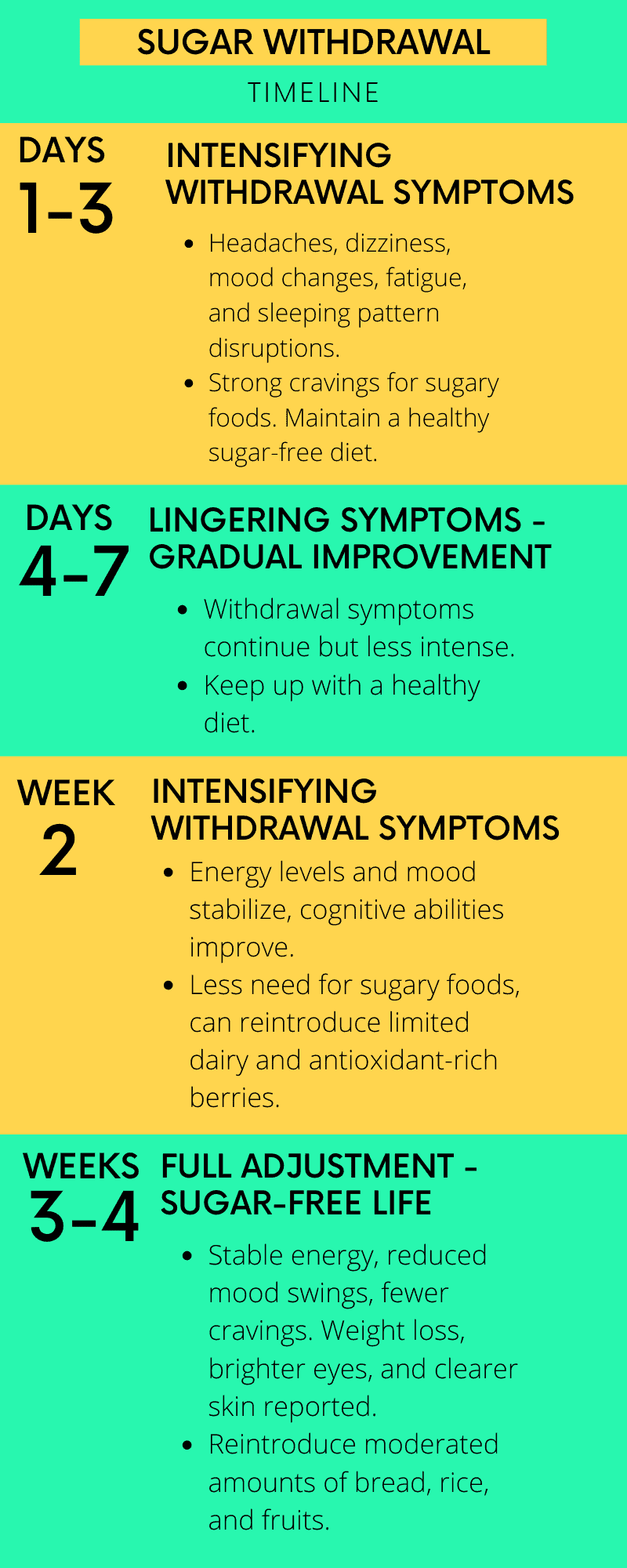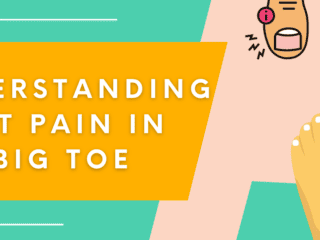Feeding into your sweet tooth cravings a lot lately? Excessive sugar consumption can result in health problems like diabetes and heart disease, so if you’re thinking of cutting off from sugar intake or avoiding it completely, this article will provide you with a detailed sugar withdrawal timeline to help you manage expectations and overcome setbacks.
- Sugar Withdrawal Timeline – Quick Reference
- Key Takeaways
- What Is Sugar Withdrawal And How Does It Affect Your Health
- Sugar Withdrawal Timeline – What To Expect
- 6-Step Plan To Remove Sugar From Your DietÂ
- Sugar Substitutes – Are They Recommended?
- FAQs
- What happens if I relapse during the sugar withdrawal process?
- Which is the worst stage of sugar withdrawal?
- What alternatives can I use to quell sugar cravings during withdrawal?
- Are sugar substitutes safe for sugar withdrawal?
- How can I manage sugar withdrawal symptoms more effectively?
- Are there any supplements that can help with sugar withdrawal?
- Conclusion
Sugar Withdrawal Timeline – Quick Reference
Intensifying withdrawal symptoms – headaches, dizziness, mood changes, fatigue, and sleeping pattern disruptions. Strong cravings for sugary foods. Maintain a healthy sugar-free diet.
â
Days 4-7:
Lingering symptoms, gradual improvement – withdrawal symptoms continue but less intense. Keep up with a healthy diet.
â
Week 2:
Notable improvements, decreased symptoms – energy levels and mood stabilize, cognitive abilities improve. Less need for sugary foods, can reintroduce limited dairy and antioxidant-rich berries.
â
Weeks 3-4:
Full adjustment, sugar-free life – stable energy, reduced mood swings, fewer cravings. Weight loss, brighter eyes, and clearer skin reported. Reintroduce moderated amounts of bread, rice, and fruits. Occasional sugary treats allowed.
Key Takeaways
- Sugar withdrawal is a prolonged period of fasting from sugary foods
- Sugar withdrawal symptoms intensify during the first 3 days, but gradually subside as the weeks go by, with significant improvements along the way
- Full adjustment to a sugar detox is typically reached around the 3rd or 4th week
- Consistency is key to a successful sugar withdrawal plan
What Is Sugar Withdrawal And How Does It Affect Your Health
Sugar withdrawal happens when you suddenly stop eating sugar after being used to eating it regularly, and you start to experience physical and mental symptoms, such as:
- Headaches
- Dizziness
- Nausea
- Fatigue
- Mood changes
- Concentration problems
- Irritability
- Anxiety
- Intense cravings
- Changes in sleeping patterns
Sugar is found in many foods and is almost impossible to avoid. It provides glucose, which is the number one food for the brain and a vital source of fuel for the body. Processed foods and refined grains create additional sugar in the body once the body metabolizes them.
While the moderate consumption of sugar isn’t harmful; excessive consumption of sugary foods and drinks can result in sugar addiction, which is a real cause for concern among health officials in the US. One study found that Americans eat too much sugar, consuming more than 300% of its recommended daily amount (RDA).
Long-term health effects like obesity, diabetes, and cardiovascular problems are often a result of excessive sugar intake. It can also impact mood, exacerbate stress, and result in other mental health problems.
Why Do People Consume Too Much Sugar?
There are many reasons why people tend to resort to sugary foods. For example, sugar releases endorphins in the body and combines with other chemicals in the body, resulting in a high but short-term surge of energy. Others believe that it’s due to the effects of dopamine on the body, like motivation, pleasure, and memory, which the release of sugar yields.
Over time they may recourse to eating more sugar to cope with stress, emotional highs, and other conditions and end up becoming dependent on it. Once it develops into full-blown sugar addiction, there is often little control over their dietary habits.
Sugar Withdrawal Timeline – What To Expect
When start to cut off sugar, your body may experience symptoms and changes for the first few days as it adjusts to the lack of sugar in your diet.
Days 1-3: Intensifying Withdrawal Symptoms
Symptoms like headaches, dizziness, mood changes, fatigue, and sleeping patterns are at their high point during the first few days. Cravings for sweets and other highly-sugared foods are also intense and may affect one’s energy, focus, and productivity for the day.
During the first few days, It’s important to consistently eat a healthy diet (sugar-free, of course) to maintain one’s health and sustain energy levels. Avoid starchy foods like rice or bread, and choose vegetables and foods rich in protein and healthy fats.
Days 4-7: Lingering Symptoms and Gradual Improvement
The withdrawal symptoms may persist as the days go but at a lesser intensity than the first three days. Continue eating healthy foods and snacks to cope with the symptoms.
Note that consistency is crucial to achieving optimal results and gaining long-term benefits.
Week 2: Notable Improvements and Decreased Symptoms
After the first week, the withdrawal symptoms start to decrease significantly. Energy levels and mood begin to stabilize, while cognitive abilities aren’t as strained as before.
You feel less of the need to buy sugared and other junk foods and beverages. You can gradually add limited quantities of dairy and fruits like antioxidant-rich berries.
Week 3-4: Full Adjustment and a Sugar-Free Life
Around this time, you’d have more stable energy levels, reduced mood swings, and fewer sugar cravings. According to a study, people may lose a considerable amount of weight after cutting sugar for a month, depending on their weight or level of sugar addiction. Some also reported brighter eyes and clearer skin.
At this time, you can add moderated amounts of bread, rice, and some fruits back into the diet. An occasional slice of cake or ice cream is also allowed, but won’t cause you to spiral back to your old cravings.
Sugar Withdrawal Timeline Visualized

6-Step Plan To Remove Sugar From Your Diet
Here are some ways to help you get through your 4-week, zero-sugar plan more effectively:
- Set achievable goals – Gradual changes are more sustainable and make it easier for your body to adjust, instead of dropping sugar instantly. For example, you can reduce your sugar intake by 25% in the first two weeks and gradually increase them as the weeks go.
- Track your sugar intake – Track the food you eat and note how much sugar they contain in a food journal or a (digital) notepad. These will help you identify the primary sources of sugar in your diet.
- Avoid highly-sugared foods – Avoid high-sugar foods like candies, ice cream, pastries, and soft drinks. Opt for healthier snacks like yogurt and fruits and drink more water or herbal teas.
- Opt for home-cooked meals – Cooking your own meals gives you free rein over ingredients and their possible sugar and nutrient content. Always check nutritional labels and avoid products with hidden sugars like high-fructose corn syrup, maltose, dextrose, and sucrose.
- Adopt healthy habits – Things like regular exercise, adopting new habits, adequate sleep, and other forms of stress relief can help reduce sugar cravings and can even promote weight loss.
Sugar Substitutes – Are They Recommended?
Opting for plant-based or natural sweeteners can offer more health benefits than refined sugar and other artificial sweeteners, all without compromising sweetness and may even add more flavor. Recommend natural sweeteners include stevia, monk fruit extract, honey, and coconut sugar.
FAQs
What happens if I relapse during the sugar withdrawal process?
Relapsing, especially within the first week, may quell your cravings temporarily, but it prolongs the withdrawal process and may cause you to spiral back.
Which is the worst stage of sugar withdrawal?
The first 3 days of the sugar withdrawal are when the symptoms like headaches, dizziness, fatigue, and mood swings are at their most intense. Sugar cravings also increase at this point.Â
What alternatives can I use to quell sugar cravings during withdrawal?
You can snack on fruits with less sugar like strawberries, oranges, and grapefruit. Incorporating protein and fiber-rich foods can also help stabilize blood sugar levels and provide you with energy. Always opt for water for hydration.
Are sugar substitutes safe for sugar withdrawal?
Natural sweeteners like stevia and non-nutritive sweeteners are okay for sugar detox, but always in limited amounts.
How can I manage sugar withdrawal symptoms more effectively?
Adopting new lifestyle habits like regular exercise, prioritizing adequate sleep, and adopting new healthy hobbies can help you get by. Always consult your healthcare provider whenever you have problems with your sugar fast.Â
Are there any supplements that can help with sugar withdrawal?
Vitamins and minerals like lipase, B vitamins, chromium, magnesium, L-glutamine, and zinc, are known for regulating blood sugar levels and reducing appetite, especially sugar cravings.
Conclusion
Cutting back on sugar intake may be difficult at first, and everyone may have a different reaction or way of coping with it, so it’s important to set realistic goals, follow a diet plan and regimen, and adopt new healthy habits to make the sugar fasting more effective and allow you to reap its health benefits in no time.
Always consult your healthcare provider regarding any dietary queries and problems.
Disclaimer: this article does not constitute or replace medical advice. If you have an emergency or a serious medical question, please contact a medical professional or call 911 immediately. To see our full medical disclaimer, visit our Terms of Use page.








